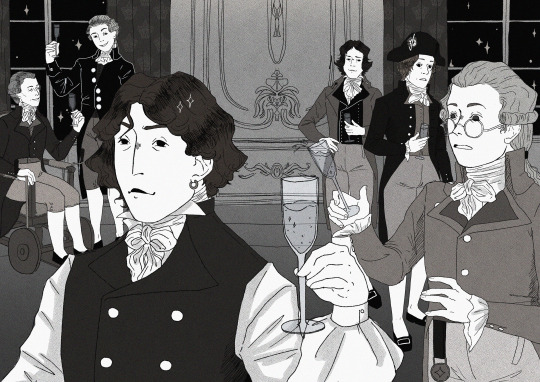#lebas
Explore tagged Tumblr posts
Text
✨Happy New Year 2024 everyone (a little bit late however)✨

#frev#french revolution#digital art#18th century art#black and white#frev art#saint just#robespierre#bonbon#lebas#couthon#barère#happy new year#new year 2024
253 notes
·
View notes
Text
I just made this meme 😈


English translation:
31 notes
·
View notes
Text










My Favorite Male Characters
#danger zone season 2 the silver ligting#liang yan dong#crash landing on you#pyo chi su#kim ju muk#geum eun dong#park kwang beom#jung man bok#a shoulder to cry on#jo tae hyun#dragon zakura 2#sakuragi kenji#cigarette girl#lebas#mafia the series: guns and freaks#sven#bloodhounds#hong woo jin#the lost tomb 2#xie yu chen#my demon#jung koo won#noble my love#lee kang hoon#my favorite male characters#kdrama#korean drama#jdrama#japan drama#thai drama
11 notes
·
View notes
Text

Renée Lebas on a vintage postcard
#postkarte#rene#postal#photography#renée lebas#postkaart#lebas#ephemera#sepia#photo#briefkaart#tarjeta#ansichtskarte#historic#carte postale#postcard#vintage
2 notes
·
View notes
Text

R13 PRE-FALL 2025
966 notes
·
View notes
Text

R13 Cable Sweater Vest RTW Pre-Fall 2024
86 notes
·
View notes
Note
pls PLEASE !!! MOAR STJUST X COUTHON !!!! 😭😭🤧🤧

#that one scene in lrf where couthon uses lebas (?) as a wheelchair#frev#french revolution#georges couthon#louis antoine saint just#saint just#couthon x saint just#ask#art tag
139 notes
·
View notes
Text

Uncanny.
“The (Lebas) marriage certificate states that it was celebrated at the Commune in the presence of Jacques-Louis David, 43, deputy, residing at the Louvre; Jacques-René Hébert, Deputy Public Prosecutor of the Commune, rue Neuve de l'Égalité. Witnesses of the spouses: Maximilien Robespierre, deputy rue Saint-Honoré, section des Piques; J.-Pierre Vaugeois, 61 years old, carpenter, uncle of the wife. The document is signed: Le Bas, Élisabeth Duplay, Hébert, David, Vaugeois.”
—
Source: Un amour en l’An II: Élisabeth Duplay et Philippe Le Bas (2021)
Hébert was present for the Lebas couple’s wedding ceremony?!?
33 notes
·
View notes
Text
Saint-Just but the My Chemical Romance version



*evil nodding*


*evil nodding* *! EYE SQUINT !*

*jaw clench*
(what the absolute shit is wrong with me that I keep noticing this?)

*jaw clench* + *! HAIR IN FACE !*
(Apparently, this came out 2 years after Spiderman 3 — you were definitely supposed to recognize the emo hair in the face as the sign of evil. This is what our devil looked like back in the day.)

Ok, in all seriousness...
I did finally get through that terrible 2009 BBC French Revolution documentary and it was so upsetting — like I actually feel shaken with how ignorant it was. And I know it's many years old, but I think there's something particularly upsetting about watching it now when we're seeing real dictatorial powers rising and freshly renewed unending war. It would be comforting to think our knowledge has been updated in the last ~1.5 decades, but my hope is... shaky. It really provokes despair to know that when people look to history to get a grasp of the world, they still find wildly distorted pictures.
I mean, wtf are they interviewing Hilary Mantel for, like she is a historian?
And nice how they bring out the innocent Girondins, but also let's skip over them pushing the country hard into war — just absolutely hurling the poor peasants and sans-culottes by the thousands into the meat-grinder of the professional European armies. As though the guillotine was the only way people were slaughtered in Revolutionary France.
(Incidentally, two books I'm reading now The Fall of Robespierre: 24 Hours in Revolutionary France [which is fairly hostile to him] and Robespierre: a Revolutionary Life [which is fairly neutral] both discuss how Robespierre was actually protecting the remaining Girondin deputies and they had to be seriously pressured [by Tallien] to turn on him.)
Ok, anyway lol.
I just decided to show my absolute disregard for trash history by romanticizing the hell out of their emo villain Saint-Just.
😊
#saint just#honestly though his cravat is adorable.#I admit to being baffled by the descriptions of Saint-Just as beautiful but maybe they were just looking at his cravat.#I mean I'm ace but honestly the Lebas portrait - I've never wanted to kiss a piece of fabric more in my life. Absolutely angelic.#And the BBC costume designers kinda got it#french revolution#frev
24 notes
·
View notes
Text

ᴛʜʀᴏᴜɢʜ ᴛʜᴇ ᴡɪɴᴅᴏᴡ
ᴡʜᴀᴛ ᴅᴏ ʏᴏᴜ ꜱᴇᴇ?
ᴛʜᴇ ᴅʀᴇᴀᴍ ʏᴏᴜ ᴀʟᴡᴀʏꜱ ʜᴀᴅ,
ᴛʜᴇ ᴡᴏʀʟᴅ ʏᴏᴜ ᴡɪꜱʜ ᴛᴏ ᴍᴀᴋᴇ?
ᴀɴᴅ ᴘᴇʀʜᴀᴘꜱ ᴏɴʟʏ ᴛʜʀᴏᴜɢʜ ᴅᴇᴀᴛʜ,
ᴄᴏᴜʟᴅ ɪᴛ ʙᴇ ᴀᴄʜɪᴇᴠᴇᴅ
10th Thermidor
#frev#french revolution#maximilien robespierre#robespierre#thermidor#10 Thermidor#sleep well Maxime:(#and bonbon and Antoine and courson and Lebas
84 notes
·
View notes
Text
Currently on a mission with Le Bas.

11 notes
·
View notes
Text

Benoît Lebas here is a co-host for a popular French radio show. Yes, yes, he's already heard the remark that he's got a face made for radio.
7 notes
·
View notes
Text

Original picture
#french revolution#frev#frev memes#almost half of these people are not even from pas-de-calais#but still#so... let's start the list#gracchus babeuf#philippe le bas#philippe lebas#joseph le bon#joseph lebon#camille desmoulins#desmoulins#antoine quentin fouquier-tinville#fouquier-tinville#martial herman#augustin robespierre#charlotte robespierre#maximilien robespierre#robespierre#louis antoine saint just#saint just#saint-just
31 notes
·
View notes
Text


ok so starting off df50.15 with a goblin focus entity mod and I ended up with this goblin as an expedition leader.
9 notes
·
View notes
Text
Frev friendships — Saint-Just and the Lebas couple

I am very happy with Saint-Just, he has talents that I admire and excellent qualities. Philippe to Élisabeth, November 1 1793. This first mission Saint-Just and Philippe went on together lasted from October 17 to December 4 1793.
Saint-Just gives you his compliments, he hopes to appease you. Philippe to Élisabeth, November 12 1793
The country where I find myself is superb. Nowhere have I seen nature more beautiful, more majestic; it is a series of high mountains, a variety of sites that charm the eyes and the heart. We went this morning, Saint-Just and I, to visit one of the highest mountains at the top of which is an old fort in ruins, placed on an immense rock. We both felt, looking around, a delicious feeling. This is the first day that we have had a break. […] We do not cease, Saint-Just and I, to take the necessary measures to ensure [an advantage] in the most prompt way; we run all day, and we exercise the most constant surveillance. When he least expects it, a general sees us arrive and is asked to account for his conduct. We are approaching Landau; soon, no doubt, it will be done; this is the end of our mission, everything invites us to hasten it. Saint-Just is almost as eager as I am to see Paris again. I promised him dinner from your hand. I’m glad you don’t hold it against him; he is an excellent man; I love and esteem him more and more by every passing day. The Republic has no more ardent, more intelligent defender. The most perfect agreement, the most constant harmony reigned among us. What makes him even dearer to me is that he often talks to me about you and consoles me as much as he can. He sets a high value, it seems to me, on our friendship, and he says things to me from time to time with a very good heart. Philippe to Élisabeth, November 28 1793
Robespierre, who had great confidence in Le Bas because he knew his wise and prudent character well, had chosen him to accompany Saint-Just, whose burning love of the homeland sometime led to too much severity, and who had a tendency to get carried away. Saint-Just had much love for my husband; he saw the chagrin that the thought of leaving me caused him. He also had friendship for me and came often enough to our house. He saw well that I would have difficulty, in the state of pregnancy I was in, bearing the chagrin of a new separation. Finally our providence, our good friend Robespierre, spoke to Saint-Just to engage him to let me depart with them, along with my sister-in-law Henriette. He consented, but with some conditions: he made us promise to see no one in the city where we were going to go, to receive no one, and to have no social relations with the inhabitants, and told us that if we did not conform scrupulously to his recommendations, he would be forced to make us leave again right away for Paris. Saint-Just and my husband, who felt all the importance of their mission, feared that we would be approached by someone seeking to influence them and trouble them in their duties. My sister-in-law was only eighteen [sic, nineteen] years old; we were both too young to have any experience; moreover we had never left our family, and we were unaware of the danger to which the least levity on our part could expose Saint-Just and my husband. Élisabeth’s memoirs, cited in Le conventionnel Le Bas: d'après des documents inédits et les mémoires de sa veuve (1901) by Stéfane-Pol, p. 131-132. Saint-Just and Lebas were ordered to go on this second mission together on 9 December 1793.
Robespierre sent Le Bas on mission with Saint-Just because he knew Le Bas to be calm and just, however ardent, and capable of moderating Saint-Just, whose vehement and passionate character would have at times been harmful to the interests of the homeland. Note written by Élisabeth, cited on page 150 of Le conventionnel Le Bas : d'après des documents inédits et les mémoires de sa veuve (1901) by Stéfane-Pol. This is almost identical to what she writes in her memoirs
Saint-Just stayed in the Rue Gaillon, close to Saint-Roch, in a furnished hotel; it was from there that we departed for the army. Note written by Élisabeth, cited on page 144 of Le conventionnel Le Bas : d'après des documents inédits et les mémoires de sa veuve (1901) by Stéfane-Pol.
We departed at last for Saverne. All four of us traveled in the same coach. Saint-Just had the most delicate attentions for me en route and the considerations of a tender brother. At each relay station, he descended from the coach to see if anything was missing, for fear of an accident. He saw me suffering so much that he feared for me. He was, at last, so good and so attentive to my sister-in-law and me that the trip did not seem long to us. My beloved was very sensitive to all his kindnesses and gave him all his recognition. To pass the time, these messieurs would read us Molière plays or some passages from Rabelais, and sang Italian airs; they made every effort to distract us and make me forget my suffering. We were very gay; no accident befell us and I rejoiced to see us at the term of our voyage. […] We were traveling in the middle of winter; one day (I must say to my shame) I started to say: “My God! What misfortune! We won’t have any wheat this year; the snow will destroy the whole harvest!” (I had never had the occasion to observe the time of year at which the harvest took place.) When I had made this remark, I saw well that I had said some inanity; my friends laughed out loud: I understood that I had said something absurd; I was all in confusion and I promised myself to speak in future only of things that I knew well. My friends saw that this had caused me pain and ceased to joke. Élisabeth’s memoirs, cited in Le conventionnel Le Bas: d'après des documents inédits et les mémoires de sa veuve (1901) by Stéfane-Pol, p. 132-133.
Finally, I glimpsed with joy the gates of Saverne. […] We took an apartment in the hotel of the general headquarters, but entirely removed from the part occupied by the officers and soldiers. We had barely arrived when we needed to separate again: Saint-Just and Philippe only rested a few minutes, to dine, before they were obliged to go risk their lives at the blockade of Landau. Before departing, Saint-Just reminded us severely to be very prudent and conduct ourselves with much circumspection, reiterating that, if it were otherwise, he would be forced to send us back to Paris. My husband also said to me: “You know, my Élisabeth, how much pain you would cause your Philippe. Also, see no one, receive no one; you would be compromising us horribly.” They left and I, greatly pained, was separated from my husband. Upon our arrival, those good friends, in their foresight, had chosen an old man, the mayor of Saverne, a venerable white-haired man, decorated by the order of Saint-Louis, to be our mentor, our protect, and our friend. My friends, who had known him previously, had great confidence in him, which he merited by all accounts. He showed us the tenderness of a father and made sure with solicitude that we lacked nothing; he walked everywhere with us and often passed the evening with us. Élisabeth’s memoirs, cited in Le conventionnel Le Bas: d'après des documents inédits et les mémoires de sa veuve (1901) by Stéfane-Pol, p. 133-134.
Saint-Just is doing well, when we have a hard time, our good friendship makes us cope better. Philippe to Élisabeth, February 2 1794
We are now very good friends, Saint-Just and I, it is not a question of anything else. We immediately acted together as usual. Gateau and Thuilliers seemed very pleased with this good harmony, they augur well and so do we. Philippe to Élisabeth, April 22 1794
My position is not pleasant, domestic sorrows are mixed with torments inseparable from my […] A thousand greetings to Henriette. I dare not speak of her to Saint-Just. He is such a peculiar man!... Farewell, my dear Élisabeth, let us hope for a happier time for us. Philippe to Élisabeth, May 15 1794
…I have not had any conversation with Saint-Just about his or my domestic affections. I am alone with my heart. Philippe to Élisabeth, May 17 1794
I received today, my dear friend, a letter from Henriette to Saint-Just and me. Saint-Just opened it, read it, and gave it to me without saying anything, as if it were intended only for me. It was about Désiré, about whom I had said two words to him on a previous occasion, to which he seemed to listen with great indifference. […] Apparently you have not received all my letters, for I have written to you almost every other day. It is my only pleasure. It is almost with you alone that I can talk, I have so few friends here! Philippe to Élisabeth, May 18 1794
I hope to see you soon. My compliments to the family, to Henriette. The person you know is still the same. I embrace you. Philippe to Élisabeth, May 22 1794
A few weeks after [10 thermidor], a young woman, dressed as a laundress and carrying a six-month-old child in her arms, appeared at the lodging house where Saint-Just had lived, and asked to speak in secret to the daughter of the landlord. The stranger was the widow of Lebas, daughter of Duplay. After the suicide of her husband, the torture of her father, the murder of her mother, and the imprisonment of her sisters, Madame Lebas had changed her name, dressed as a woman of the people, and earned her living and that of her child by washing linen on the boats that served as washhouses on the river. Only a few persecuted republicans knew of her disguise and admired her courage. She had no inheritance, no trace, no portrait of her husband left. She silently adored his memory. The young fugitive had learned that Saint-Just's hostess, a professional painter, owned a portrait of Robespierre's disciple painted by her shortly before his execution. She had a burning desire to possess this painting, which would at least remind her of her husband in the figure of the young republican, Lebas's dearest colleague and friend. The young artist, herself reduced to poverty by the imprisonment of her own father, prosecuted as a guest of Saint-Just, demanded six louis for her work. Madame Lebas did not possess this sum. She had saved from the sequestration only a trunk of clothes, linen, and wedding clothes, her only fortune. She offered this trunk and all that it contained as the price of the portrait. The exchange was accepted. The poor widow brought her clothes that night and took away her treasure. Thus, through conjugal love, the only image of this young revolutionary was preserved for posterity. Histoire des Girondins (1847) by Alphonse de Lamartine, volume 8, p. 374-375. On page 325-326 of Le conventionnel Le Bas: d'après des documents inédits et les mémoires de sa veuve(1901), Stéfane-Pol notes that Élisabeth wrote down objections to certain details in this account in the edition of the book that she owned (her having taken on a different surname and being dressed as ”a woman of the people” for the occasion). It can furthermore be noted that Élisabeth would have been unable to obtain this portrait of Saint-Just just ”a few weeks” after thermidor, considering she herself would remain imprisoned until December 1794. Stéfane-Pol nevertheless concluded that this by Lamartine recorded episode probably had taken place in some form or another. As can be seen through the following testimonies, Élisabeth did in her old age indeed possess a portrait of Saint-Just, and Lamartine had indeed interviewed her.
Madame, Since you are so kind as to lend me the portrait of Saint-Just, please entrust it to the bearer of this note; you will oblige me greatly. I will do my utmost not to deprive you of it for too long. Please accept, Madame, the assurance of my respectful devotion. Letter from Pierre-Jean David D’Angers to Élisabeth, December 18 1845, cited in Veuve de Thermidor: le rôle et l'influence d'Élisabeth Duplay-Le Bas (1772-1859) sur la mémoire et l'historiographie de la Révolution française (2023) by Jolène Audrey Bureau, page 412.
Madame Lebas, wife of the Convention deputy and daughter of Dupleix [sic], the carpenter with whom Robespierre lived, had lent me a pastel portrait of Saint-Just. As soon as my bust was finished (in 1848), I asked this lady to come and see it. When she entered my studio, the memory of the young representative of the people brought tears to her eyes: "Poor young man!" she said, "I seem to remember him still, leaning against the foot of my bed where I was nursing my son. My husband was beside him. They were talking about very serious things, about the army from which he had just returned. He was handsome, Saint-Just, with his pensive face, on which one could see the greatest energy, tempered by an air of indefinable gentleness and candor." Les Carnets de David d’Angers (1958) by Pierre-Jean David d’Angers, volume 2, p. 87, cited in Veuve de Thermidor: le rôle et l'influence d'Élisabeth Duplay-Le Bas (1772-1859) sur la mémoire et l'historiographie de la Révolution française (2023) by Jolène Audrey Bureau, page 127.
[Saint-Just] had a very low forehead, so that his hair, without being long, almost touched his eyes. This singularity is striking in the beautiful portrait that Madame Lebas has, and at first I thought it was an accident, a clumsiness of the painter. But this venerable lady, who saw and knew Saint-Just well, assured me that he indeed had looked like that. Histoire de la Révolution française (1878) by Jules Michelet, volume 6, page 116.
I found in Madame Lebas a woman from the Bible after the dispersion of the tribes in Babylon, withdrawn from the commerce of the living in the upper floor of a modest apartment, conversing with her memories, surrounded by portraits of her family decimated on 18 Fructidor [sic]. […] A magnificent pastel portrait of Saint-Just, that Barbaroux of the terrorists, that Antinous of the Jacobins, was placed in a gold frame against the wall between the bed curtains and the door, the object of a cult of young girlish memory for the most seductive of the disciples of the tribune of death. […] Saint-Just also played a large role in [Élisabeth’s] memory. I imagine that before marrying Lebas, the young daughter of the carpenter Duplay, Robespierre's host, had at one point thought of becoming the wife of the young and handsome proconsul. […] Whenever the name of Saint-Just came up in our conversations, the accent and the physiognomy visibly softened in Madame Lebas, and a look of retrospective enthusiasm rose from the portrait to the ceiling, like a silent reproach to heaven for having cut off some sweet perspective, with the axe of 1794, with this head of an exterminating angel. Critique de l'Histoire des Girondins par l'auteur des Girondins lui-même (1861) by Alphonse de Lamartine, p. 102, 104-105.
[Élisabeth’s] memories hardly went beyond the circle of intimate relationships; but as from 93 the house of Duplay became the center towards which all political life around Robespierre converged, she had spent her youth at the very heart of the Revolution. She had loved her husband, as she herself said, with a patriotic love; but through a reserve and a delicacy of heart that women will understand, it was the one she talked about the least. From Saint-Just, from Couthon, from Robespierre the younger, she cited beautiful and good deeds that had touched her. Her great admiration was for Maximilien. Histoire des Montagnards (1875) by Alphonse Esquiros, page 2. Section titled ”my witnesses.”
[Edgar Degas] told me that, when he was a child, his mother one day took him to rue de Tournon to visit Madame Lebas, widow of the famous Convention deputy who, on 9 thermidor, killed himself with a pistol. When the visit was over, they withdrew with small steps, accompanied to the door by the old lady, when Madame Degas suddenly stopped, deeply overwhelmed. Letting go of her son's hand, she pointed at the portraits of Robespierre, of Couthon, of Saint-Just, that she had just noticed were hanging on the walls of the antechambre, and she couldn’t keep herself from crying out with horror: ”What! You still keep the faces of these monsters here!” ”Be quiet, Célestine!” Madame Lebas cried out ardently, ”be quiet… They were saints!” Discours de l’Histoire prononcé à la distribution solennelle des prix du Lycée Jeanson-de-Sailly held by Paul Valéry on July 13 1932, cited in Robespierre ou les contradictions du jacobinisme (1978) by Albert Soboul.
To speak of General Burnouf: he conducted himself quite badly with me after the death of my Philippe. That man owed him his life. He and General Jourdan found themselves compromised in an affair which was a matter of nothing less than life and death. Le Bas, Saint-Just, Robespierre, and other patriotic deputies saw well that it was a betrayal, that they were innocent; but above all that they needed to be hidden from their denouncers. Le Bas hid Burnouf for forty-eight hours, and Saint-Just hid General Jourdan with one of his friends. These good friends passed two days at the General Committee defending them and demonstrating their innocence. It was proved that some sought already to attack the true friends of the homeland, and it was recognized later that it was the same traitors who conspired underhandedly against the friends of the Republic: it was Tallien, Fouché, Rovert, Bourdon de l’Oise, Collot d’Herbois, [Billaud] Varennes… Note written by Élisabeth, cited on page 144-145 of Le conventionnel Le Bas… (1901)
Volume 4 — page 341: ”Saint-Just… mute as an oracle and sentient as an axiom, seemed to have stripped away all human sensibility to personify in him the cold intelligence and the ruthless impulse of the Revolution, etc… his passion had, so to speak, petrified his entrails. His logic had contracted the impassiveness of a geometry and the brutality of a material force. It was he who, in intimate and long-lasting conversations in the night under Duplay's roof, had most combated what he called Robespierre's weaknesses of soul and his reluctance to shed the king's blood, etc.” (In the hand of the son of Lebas): My mother did not recognize Saint-Just in this portrait. Where do you know this from?" Philippe Lebas junior comments a passage in Alphonse Lamartine’s Histoire des Girondins (1847), cited in Le conventionnel Lebas: d’après des documents inédits et les mémoires de sa veuve (1901) by Stéfane-Pol, p. 327.
Volume 6 — page 300: ”Love warmed, without softening, the hearts of these men. Couthon's tenderness for the devoted woman who consoled his infirm life, Saint-Just's stormy and passionate feelings for Lebas's sister, Robespierre's grave and chaste predilection for his host's second daughter, Lebas's love for the youngest, etc…” Correction: very calm feelings. Élisabeth comments a passage in Alphonse Lamartine’s Histoire des Girondins (1847), cited in Le conventionnel Lebas: d’après des documents inédits et les mémoires de sa veuve (1901) by Stéfane-Pol, p. 329.
Volume 7 — page 105: ”Fort Vauban was taken by the Austrians, Landau was about to fall. Saint-Just and Lebas were sent to Alsace to intimidate treason or weakness with death.” (Mark of protest.) Élisabeth comments a passage in Alphonse Lamartine’s Histoire des Girondins (1847), cited in Le conventionnel Lebas: d’après des documents inédits et les mémoires de sa veuve (1901) by Stéfane-Pol, p. 329.
Volume 7 — page 341: ”Saint-Just… brought to the battlefield the enthusiasm of his youth and the example of an intrepidity that astonished the soldier. He spared no more his blood than his fame, etc…” So his heart was not petrified then. Élisabeth comments a passage in Alphonse Lamartine’s Histoire des Girondins (1847), cited in Le conventionnel Lebas: d’après des documents inédits et les mémoires de sa veuve (1901) by Stéfane-Pol, p. 329.
#forget the whole ”sexual tension between danton and both halves of the desmoulins couple” trope#when can we get ”philippe and élisabeth both have a crush on sj”?#saint-just#philippe lebas#élisabeth lebas#élisabeth duplay#frev#frev friendships#élisabeth le bas#philippe le bas#louis antoine saint just#long post#also élisabeth little snarky annotations are the BEST
65 notes
·
View notes
Text

R13 FW24 RTW
170 notes
·
View notes